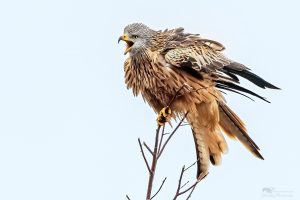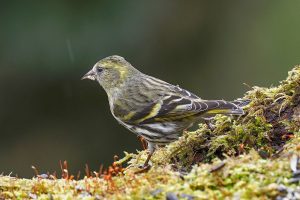Report: Breeding Birds in the Netherlands 2020
June 7, 2022
In spring, a new breeding bird report looking back at season 2020 was published. The report summarises the main results of the national Breeding Bird Monitoring Network in 2020, organised by Sovon Vogelonderzoek Nederland in collaboration with Statistics Netherlands (CBS, responsible for quality assurance). The publication, including an English summary, is available for download.
The report covers both general and rare species (Breeding Bird Monitoring Project, BMP) and colony birds. Subprojects of the BMP include the Farmland Bird Monitoring Network, the Freshwater Waters Monitoring Network and the Coastal Breeding Birds Wadden Monitoring Network. In addition, the authors had included data from the special monitoring networks for breeding birds in urban and agricultural areas, the data on changes in breeding success collected via the Nest Map Monitoring Network, as well as the data on survival and breeding success of small songbirds monitored with the Constant Effort Sites (CES) monitoring network.
Besides a discussion of method and material (Chapter 2) and weather conditions and water levels in 2020 (Chapter 3), the main developments in breeding birds in that year are discussed, with particular attention also paid to regional monitoring networks and trends (Chapter 4). Table 4.1 summarises numbers and estimates of colony birds and rare breeding birds. The national indices are given in Appendix 2 and, like the regional indices, are also available from the Sovon website (sovon.nl/soortinformatie). The same applies to trends and information in the Natura 2000 areas. Finally, the species are discussed in Chapter 5, where more attention is paid to the developments at the habitat level this year. The species are divided into the following habitats: farmland, forest, dune and heathland, urban area, freshwater and saltwater.
Material and methods
The fieldwork was primarily carried out by volunteers, with essential help from professional birders working for, among others, site management agencies, provincial departments, Rijkswaterstaat and Sovon (Figures 2.2, 2.3, Table 2.2). Species-specific (national) research, carried out by working groups and individuals, provides important support (Table 2.3). Fieldwork is carried out according to the guidelines in the manual (Vergeer et al., 2016). The coordination of the monitoring networks is in the hands of Sovon. There is close cooperation with (volunteer) District Coordinators for colony birds and rare breeding birds. The trend calculation by CBS uses the program RTRIM (Trends & Indices for Monitoring data), where estimates are made for missing data.
Key outputs in 2020
In the long term, 80 species (40%) showed a strong or moderate decrease, and 95 species (48%) showed a strong or moderate increase. The remaining species remained stable (22; 11%) or had an uncertain trend (Little Gull). In the short term, 55 species decreased (28%), 84 species increased (42%), and the remainder were stable (37 species, 19%) or had an uncertain trend (22 species; 11%, including the ‘extinct’ species: Tawny Pipit, Great Grey Shrike and Ortolan Bunting).
Winter 2019/20 was the second mildest since records began in 1901, followed by the sunniest spring yet recorded. That was not only very mild but also very dry; the average precipitation across the country was 77 mm (normal average of 172 mm), almost all in the first two weeks of March. The summer was also very sunny and warm, with average precipitation and an exceptionally long heat wave in August.
Despite the mild winter, the number of Little Egrets decreased (2019: 67–75, 2020: 50–60), showing that winter weather is not the only determining factor of the trend; breeding success and nesting opportunities will also play a role, as we see, for example, in the Red-backed shrike. Due to the dry summers of recent years, many nests succeeded early in the season. As a result, the young probably fledged at a good weight and had a long time to fatten up before migration, increasing their chances of survival, thus increasing the population size.
Some of the biggest winners in 2020 are relative newcomers to our country. In chronological order: Middle Spotted Woodpecker, Eurasian Eagle Owl, Common Crane, Cetti’s Warbler, White-tailed Eagle, Whiskered Tern and Caspian Gull. These species reached record numbers in 2020, as did Montagu’s Harrier (80 pairs) and Red Kite (20 pairs). There were also positive reports for species that have been nesting in our country for a long time. For example, White Stork continued its long-term increase with around 1200–1300 pairs in 2020. Eurasian Bittern benefits regionally from nature development, and the index value shows an almost annual increase since 2008 (2020: 530–610 pairs). Many species also benefited from the rainfall persisting for several years in the Sahel, such as Savi’s warbler, Yellow Wagtail, Bluethroat, Common Redstart, Sedge Warbler, Marsh Warbler, Eurasian Reed Warbler, Lesser Whitethroat, Common Whitethroat, Purple Heron, Littel Bittern and Wryneck. For the Kestrel, it is likely that the successful year 2020 was due to a good food supply for the young the year before (mice year). Further, there was a rebound in Partridge, but what caused it was less well explained.

The pairs of breeding Red Kites reached record numbers in 2020 in the Netherlands. Photo by Zdeněk Pachovský (gurushots.com/zdenek.pac/photos)
The list of losers includes species that we may be losing as breeding birds: Ruff, European Serin and Penduline Tit. The dramatic decline is in Lesser Redpoll, and the Corn Bunting is no longer an annual breeding bird. Eider Duck continued its negative long-term trend, as did the Arctic Tern. It is not clear what underlies the relatively low number of Goldcrests. The index value was a quarter below the reasonably stable level of 2015–19. Of the 100–130 pairs of Short-eared Owls from the peak year 2019, only 10–20 remained in 2020, returning to the pre-peak level (2015–18: 10–25). The numbers of Red Crossbills and Eurasian Siskins are known for their fluctuations, although it is notable (especially for Siskins) that the high peaks of the 1990s are no longer reached recently. Also, good and bad years alternate for the Spotted Crake and the Corncrake, but good years do not occur anymore for the latter. Annual fluctuations are also known for Black-winged Stilt, where the low numbers in 2020 may have resulted from drought in the spring. The same applies to Red-necked Grebe and Black-necked Grebe (the lowest number in 10 years).

The numbers of Eurasian Siskins regularly fluctuate, however they don´t reach the high peaks of the 1990s. Photo by František Vaňásek (Flickr CSO)
Most provinces have their monitoring networks, usually focused on farmland bird species. Together with the regular breeding bird censuses, these make it possible to calculate regional trends for many species. The regional trends differ from the national picture. In total, it concerns 1235 trends of 164 species. Reliable trends of more than 100 species are available from eight provinces, and some trends are available for each province from 1990 onwards (Grey Heron, Barn Owl, Sand Martin). The number of Gold Finches increases almost everywhere in the long term (except Flevoland: stable), with the strongest growth in the provinces occupied by the species later: Drenthe, Limburg, North Brabant, Friesland and Overijssel.
More than 3,000 volunteers
We can only gain these insights thanks to the counting efforts of more than 3000 volunteers. So naturally, we would like to thank all these counters who, mostly in their spare time, conducted the counts and made their data available to Sovon.
Broedvogels in Nederland in 2020, available for download in PDF (9,3 MB), 148 pages

The national indices of a total of 198 breeding birds with above the figure the trend indication
over the period of the flexible trend line. For more common species usually the trend over 1984–2020 is shown in the figure, for colony birds and rare breeding birds the trend line usually covers the period 1990–2020 and index values in 1980–89 are included as a supplement (without line; due to other calculation methods, the trend line is not included).
The flexible trendline was calculated with the MSI tool in R from CBS (Boogaart et al. 2016). For species missing from this overview no reliable index can be calculated. For extensive species information see stats.sovon.nl.
